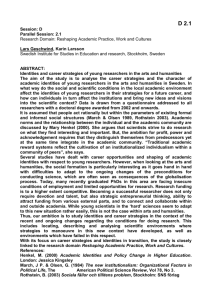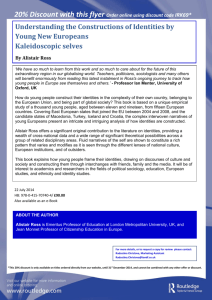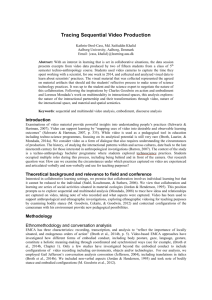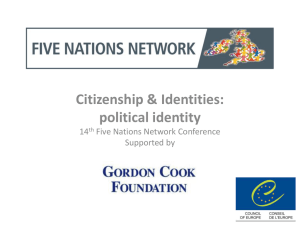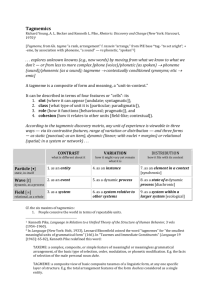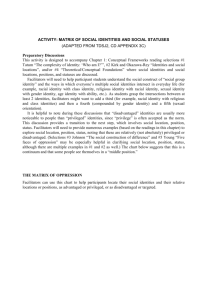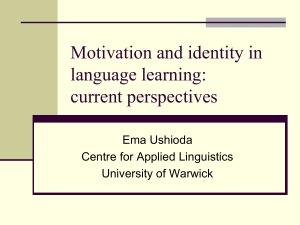Social Learning Theories: Conversation Analysis
advertisement
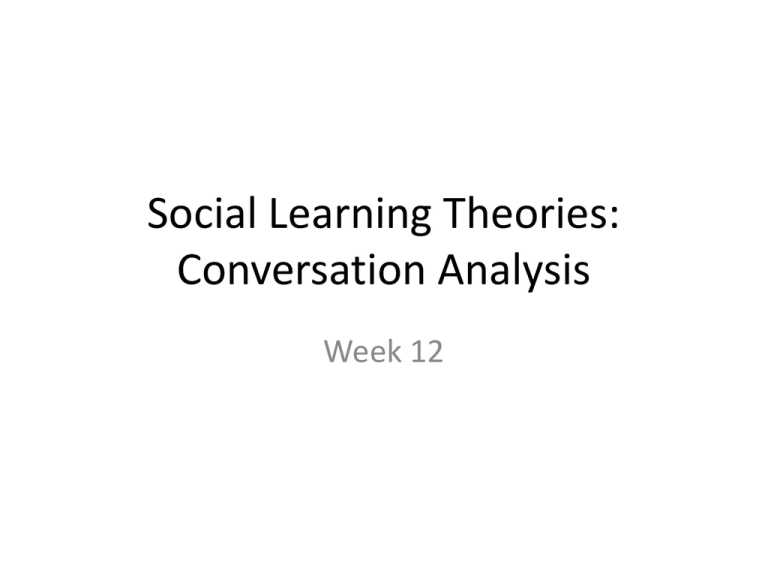
Social Learning Theories: Conversation Analysis Week 12 Tonight • Warm-up • Introduction to Conversation Analysis (Kasper & Wagner, 2011) • Discussion Lead 1: Seedhouse (2005) • Discussion Lead 2: Mondada & PekarekDoehler (2004) • Discussion Lead 3: Wilkes-Gibbs (1997) • HW Warm-up • What social aspects figure into learning from a language socialization view of SLA? Introduction to Conversation Analysis: Kasper & Wagner (2011) • The focus of CA as an approach to second language acquisition (SLA)—or CA-SLA for short—is therefore the social aspects of language acquisition • What social aspects are they referring to? • From EMCA perspectives, language acquisition can be understood as learning to participate in mundane as well as institutional everyday social environments. • CA, therefore, does not treat language as an autonomous system independent of its use; rather, it treats ‘grammar and lexical choices as sets of resources which participants deploy, monitor, interpret and manipulate’ (Schegloff et al. 2002: 15) in order to perform their social acts. • Interaction is orderly, first and foremost, for the participants themselves. • Why is interaction so important? Intersubjectivity • When learners are faced with interdependent tasks, they have to negotiate shared meanings with each other (Wertsch, 1985). To do so is to develop intersubjectivity. • As Drew (2005, p. 75) put it: “The aim of research in CA is to discover and explicate the practices through which interactants produce and understand conduct in interaction.” • Membership in a social group, then, is constituted by effective, morally accountable participation. • In CA-SLA, interactional competence is understood to serve double duty • What does this mean? • CA relocates cognition from its traditional habitat in the privacy of people’s minds to the arena of social interaction. • How? And Why? • How does CA’s view of identity differ from the more recent ideas of identity we have discussed? • Such “transportable” identities (Zimmerman, 1998) may be visible (through physical appearance) or hearable (through speech production) across situations and activities without having any bearing on the interaction for the participants. • Why this view? • Much of the literature on L2 talk shows that, predominantly, participants do not treat their status as L1 or L2 speakers (e.g., Brouwer, 2003; Hosoda, 2006) or their cultural backgrounds (Mori, 2003; Ryoo, 2007) as relevant for their interaction. • In other words, transportable identities are a resource for participants—the identities’ local relevance is subject to the parties’ interactional projects at any given moment in their talk. • Identities, then, are not assumed to reside in a person but are interactionally produced, locally occasioned, and relationally constituted • Against theory-stipulated analytical priorities, CA adheres to the policy that no aspect of the data can be dismissed as “uninteresting” a priori. • Why does this happen and how does it relate to CA’s position on exogenous theories? • Unmovtivated and motivated looking? Discussion Lead 1: Seedhouse (2005) • Listening for: – Theoretical assumptions – Focus of CA – Specific components of conversation analyzed – Implications for practice Q’s • How do contributions to interaction both shape and renew context? • Contributions are context-shaped in that they cannot be adequately understood except by reference to the sequential environment in which they occur and in which the participants design them to occur. • Contributions are context-renewing in that they inevitably form part of the sequential environment in which a next contribution will occur. • The basic aim is to establish an emic perspective, i.e. to determine which elements of context are relevant to the interactants at any point in the interaction. The perspective is also an active one in which participants talk a context into being. What is the main point? • [t]he etic viewpoint studies behaviour as from outside of a particular system, and as an essential initial approach to an alien system. The emic viewpoint results from studying behaviour as from inside the system . . . Descriptions or analyses from the etic standpoint are ‘alien’ in view, with criteria external to the system. Emic descriptions provide an internal view, with criteria chosen from within the system. • So it is incorrect to say that CA does not consider background or contextual details; • How does CA consider these then? • The essential question which we must ask at all stages of CA analysis of data is ‘Why that, in that way, right now?’ • This encapsulates the perspective of interaction as action (why that) which is expressed by means of linguistic forms (in that way) in a developing sequence (right now). • Interactional organisations of turn-taking, adjacency pairs, preference organisation and repair are often misunderstood by linguists to be a system of units and rules in the descriptivist linguistic sense and to constitute the methodology of CA. • The interactional organisations themselves are stated in context-free terms, but the vital point is that participants employ these context free organisations in a contextsensitive way to display their social actions. • It is because the participants (and we as analysts) are able to identify the gap between the context-free model and its context sensitive implementation that they (and we as analysts) are able to understand the social significance of the context-sensitive implementation. Discussion Lead 2: Discussion Lead 2: Mondada & Pekarek-Doehler (2004) Q’s • That is, language learning involves much more than an expert-novice relationship and much more than scaffolded sequences of negotiation. • What else, then? • More specifically, language learning is rooted in learners' participation in organizing talk-in-interaction, structuring participation frameworks, con- figuring discourse tasks, interactionally defining identities, and becoming competent members of the community (or communities) in which they participate, whether as students, immigrants, professionals, or indeed any other locally relevant identities (see also He, this issue; Kasper, this issue; Mori, this issue, for related insights). Such participation gives rise to cognitive practices, forms of attention, and conjoined orientations that are embedded, publicly exhibited, and made recognizable in actual actions, and are socially mediated and collectively monitored through interaction. Discussion Lead 3: Wilkes-Gibbs (1997) • Grounding, language as collaboration Problems • Clark (1994) • There are two principles here: (1) the problems that arise in language use are joint problems; and (2) dealing with these problems requires joint management. Activity • 4 levels of collaboration with language use problems. • Each have 1 level. • Read and then share. HW • Atkinson (2011) Ch 6, A sociocognitive approach to second language acquisition • Discussion lead: Cekaite 2008 Embodied action: keum,jihyun • Discussion lead: Reinhardt (2008): Rick • Van Lier (2004), The ecology and semitoics of language learning: A sociocultural perspective. ---Chapter 1 • Reader response


